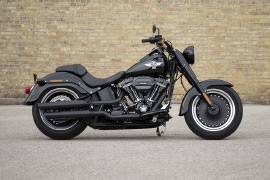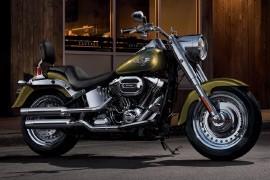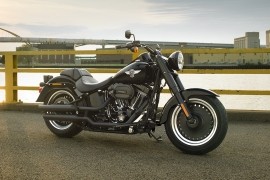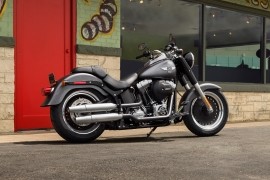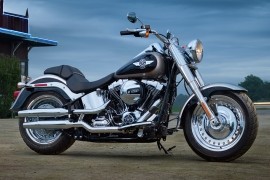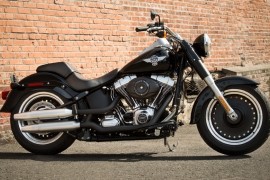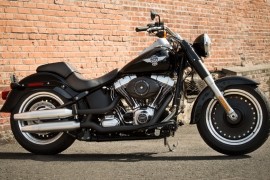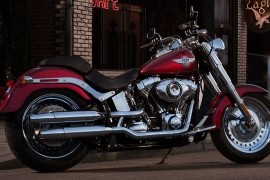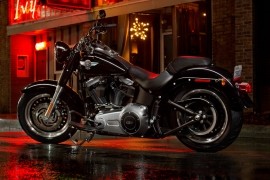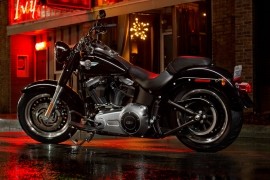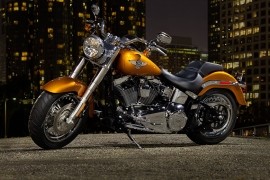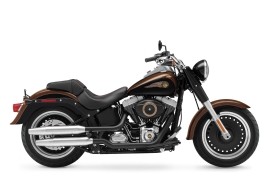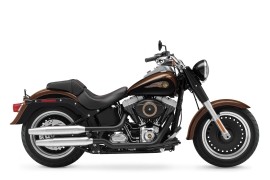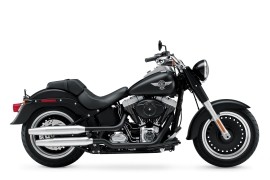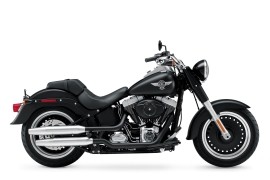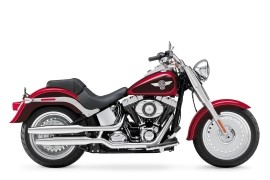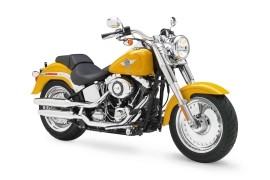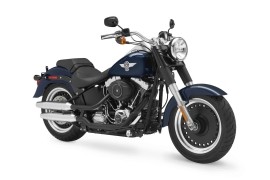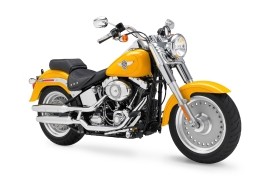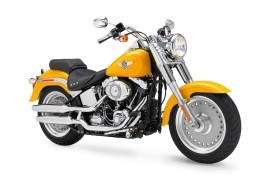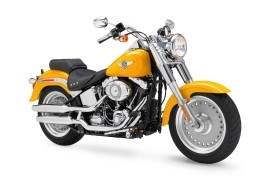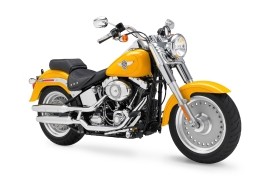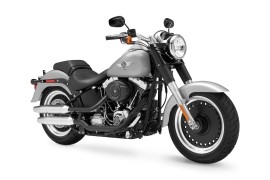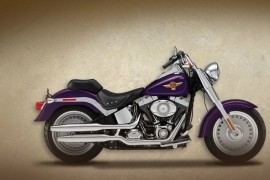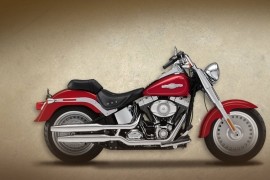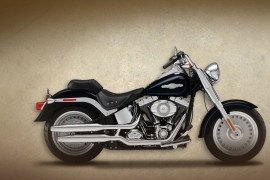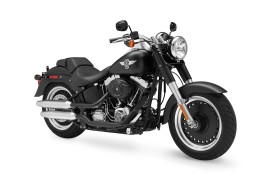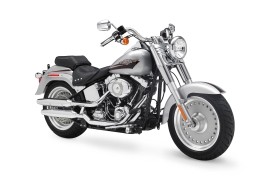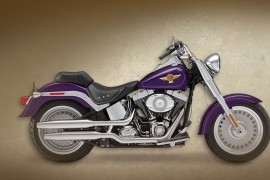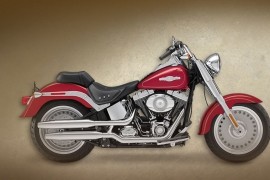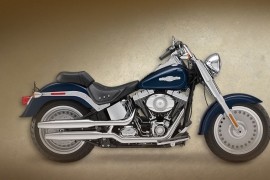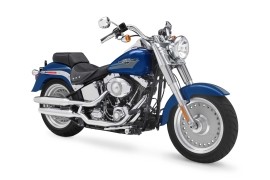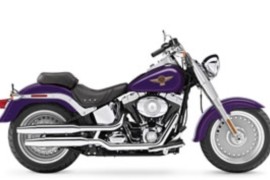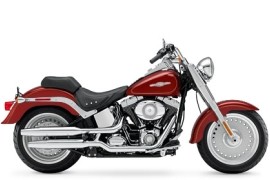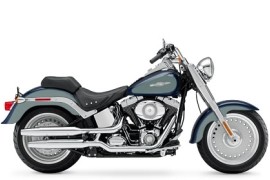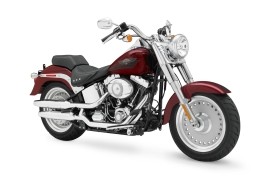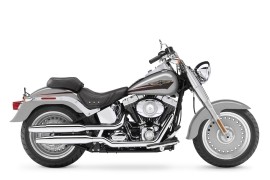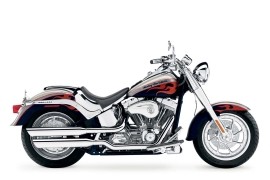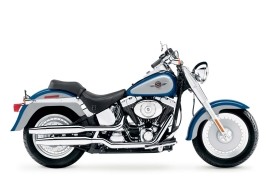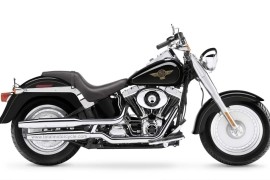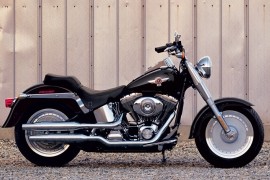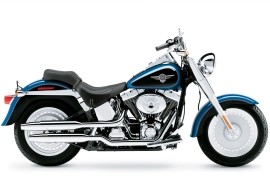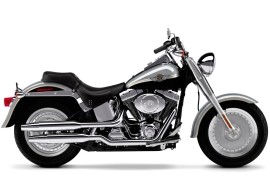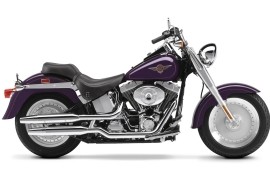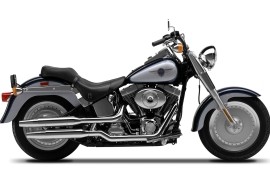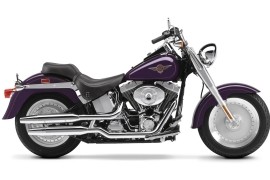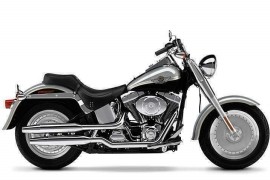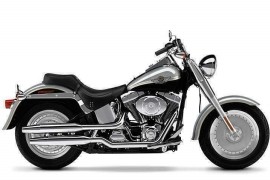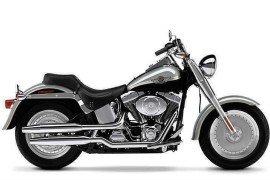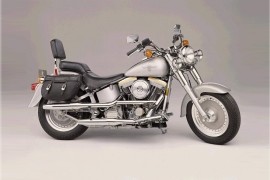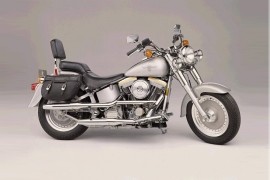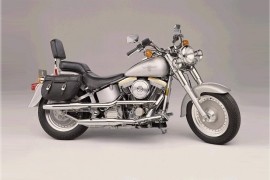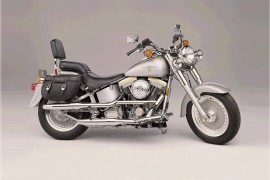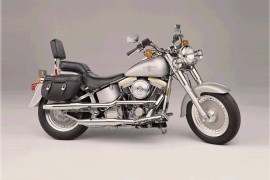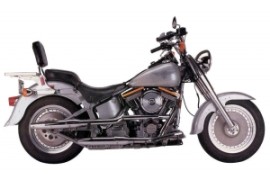HARLEY-DAVIDSON Fat Boy Models/Series Timeline, Specifications & Photos
First production year: 1990
This takes dark to a new level. A powerful one. New gloss black Screamin’ Eagle Air-Cooled Twin Cam 110B engine, gloss black lower forks, axle nut covers, handlebar and riser. Black brake lever and hydraulic clutch assembly. Black over/under shotgun exhaust with slash cut mufflers. Take our word for it, it is blacked out from front to back and head to toe in attitude.
Harley-Davidson was an American motorcycle manufacturer founded in 1903 with a home base in Milwaukee, Wisconsin, United States. H-D was one of two significant motorcycle manufacturers that survived the Great Depression.
In 1990, the American motorcycle manufacturer launched a Softail cruiser motorcycle under the Fat Boy designation. The bike rolled on solid disc aluminum wheels and was also known as the FLSTF from 1990 to 2017, while from 2018, it was known as FLFB and FLFBS.
Over its production period, the Harley-Davidson Fat Boy underwent several design and technical modifications, including several displacements increases. In addition, The Fat Boy was the base model for various versions with slightly different characteristics.
In 2017, the maker launched the Harley-Davidson Fat Boy, a cruiser motorcycle with a classic style loaded with modern technology that came with a new battery tender harness and new color options.
In the appearance department, the 2017 Harley-Davidson Fat Boy featured a black frame, a black front fender with a chromed fork and headlight housing, a black fuel tank with an integrated chromed instrument panel, a black powder-coated engine with chromed head covers and fins, a black rear fender, and a dual chromed exhaust system.
As for power, the 2017 Harley-Davidson Fat Boy took its muscles from a 1,690cc V-twin air-cooled engine fed by an electronic fuel injection system, delivering smooth engine response, fast acceleration, and 132 Nm (97 lb-ft) torque with a maximum peak at 3,250 rpm.
In 2023, the bike was for sale at a price ranging between $14,000 and $17,000, depending on its condition and miles.
In 2016, the American motorcycle maker launched the Harley-Davidson Fat Boy S, a cruiser machine derived from the Standard Fat Boy. The S model was a most aggressive version of the Fat Boy's range, with a dark look and a Screamin' Eagle engine that delivered more power.
The bike rolled on bullet-hole full-disc aluminum wheels with satin-chromed rims and fat tires covered by black-finished valanced fenders. Compared to other versions of the Fat Boy, the Fat Boy S was the most darker.
The bike packed a completely blacked-out fork on the front with a black headlight housing and handlebar. In the middle, the black-finished components included the fuel tank with the integrated instrument panel, the engine with polished cooling fins, and black covers. On the rear, it packed a black fender, black leather seats, and an exhaust system.
In the performance department, the 2016 Harley-Davidson Fat Boy S packed a 1,801cc Twin Cam 110B Screamin' Eagle engine with an Electronic Sequential Port Fuel Injection (ESPFI) system, delivering excellent power, fast acceleration, smooth throttle control and 146 NM (108 lb-ft) torque at 4,000 rpm.
The bike's suspension was handled by a 41 mm telescopic fork on the front and a hidden horizontal-mounted shock absorber on the rear that created a classic hardtail design, offering excellent suspension performance and handling.
The 2016 Harley-Davidson Fat Boy S was for sale in 2023 (at the time of writing), with a price ranging from $14,500 to $17,000.
The Harley-Davidson Fat Boy was a cruiser machine manufactured by H-D since 1990, known as the FLSTF from 1990 to 2017, while from 2018, it was coded as FLFB and FLFBS.
Over its production period, the Harley-Davidson Fat Boy underwent several design and technical modifications, including several displacements increases. Starting from 1990 with a 1,340cc displacement and growing to 1,746cc on the FLFB and 1,868cc on the FLFBS in 2018.
Also, a false etymology circulated, claiming the name was a contraction of Fat Man and Little Boy atomic bombs dropped on Japan in WW2. However, it proved to be a simple descriptive name and had nothing to do with their Japanese competitors.
The Fat Boy was the base model for various versions, including the Harley-Davidson Fat Boy Special, a cruiser machine with an aggressive, darker, and more modern-looking appearance.
The bike featured a blacked-out appearance in the visual department, with black accents that replaced the usual chrome. Also, the bike featured many black elements, such as the fenders, headlight housing, fuel tank, engine, and bullet-hole full-disc aluminum wheels with satin-chromed rims.
As for power, the 2016 Harley-Davidson Fat Boy Special took its muscles from a 1,690cc four-stroke V-twin air-cooled engine, with an electronically controlled fuel injection system in charge, delivering excellent power and 132 Nm (97 lb-ft) torque at 3,250 rpm.
In 1990, Harley-Davidson released their first Fat Boy motorcycle, a cruiser machine with solid disc wheels, also known as the FLSTF, from 1999 to 2017 and starting with 2018, coded as FLFB and FLFBS.
Some said the Fat Boy name came as a symbolic insult to the Japanese motorcycles, from a contraction of Fat Man and Little Boy, two atomic bombs used on Japan in World War Two. In 2015, H-D's styling and product development vice president Scott Miller confirmed that the bike's name was descriptive, coming from the wide appearance when viewed head-on.
Over its production time, the Harley-Davidson Fat Boy underwent several design and technical modifications and several displacement increases. It started in 1990 with a displacement of 1,340cc and ended in 2018 with a displacement of 1,746cc on the FLFB model and 1,868cc on the FLFBS version.
In 2016, the American motorcycle maker launched the Harley-Davidson Fat Boy, a classic-looking machine loaded with modern technology, such as Anti-Lock Braking System (ABS), a six-speed Cruise Drive transmission, and a factory-installed smart security system with a hands-free fob.
The 2016 Harley-Davidson Fat Boy was loaded with shiny chrome accents, including the headlight housing, front fork, engine head covers, cooling fins, bullet-style turn signal housings, exhaust system, and bullet-hole solid disc aluminum wheels.
In the performance department, the bike had its soul brought to life by a 1,690cc four-stroke air-cooled V-twin engine, with an electronic fuel injection system in charge, delivering excellent throttle response, fast acceleration, and 132 Nm (97 lb-ft) torque at 3,250 rpm.
Harley-Davidson was an American motorcycle manufacturer founded in 1903 with headquarters in Milwaukee, Wisconsin, United States. It was one of two large American motorcycle manufacturers that survived the Great Depression, along with their historical rivals, Indian Motorcycles.
In 1990, Harley-Davidson created a line of cruiser motorcycles under the Fat Boy designation, which many believed was a contraction of the Fat Man and Little Boy atomic bombs dropped on Japan in WW2. Still, it proved to be only a descriptive name.
The Harley-Davidson Fat Boy was the base model for several versions with the same design and technical features but slightly different characteristics. One of which was the Fat Boy Lo, the same machine but with a lowered suspension and a darker appearance.
In 2015, the American motorcycle maker launched the Harley-Davidson Fat Boy Lo, a cruiser motorcycle part of the Fat Boy series, that came with a lowered suspension for better reach to the ground and a blacked-out, more aggressive appearance.
As for the power figures, the bike had a 1,690cc four-stroke air-cooled V-twin engine with a black powder coating and satin-chromed head covers and cooling fins. The engine was fed by an electronically controlled fuel injection system that delivered smooth power and 132 Nm (97 lb-ft) torque at 3,250 rpm.
The bike's lowered suspension was handled by a telescopic fork on the front and a hidden, horizontally-mounted shock absorber on the rear, providing excellent suspension performance, handling, and a hardtail design.
The Harley-Davidson Fat Boy was a cruiser machine manufactured by H-D since 1990. The bike was first released in 1990 and was also known as the FLSTF until 2017, and from 2018, it was coded as FLFB and FLFBS.
The Fat Boy featured a fat appearance and was loaded with classic-looking features, including a wide handlebar, a teardrop-shaped fuel tank with an integrated instrument panel, a two-piece dual seat, valanced fenders, and full-disc aluminum wheels.
It was the base model for several versions, including the Fat Boy Special, which shared many design and technical features but had a darker appearance and few visual elements that made it look more aggressive.
In 2015, the American motorcycle manufacturer launched the Harley-Davidson Fat Boy Special, a more aggressive-looking machine than the standard model due to its darker appearance.
The bike featured a black powder-coated 1,690cc V-twin air-cooled engine with satin-chromed head covers and cooling fins, black fenders, black bullet-hole full-disc aluminum wheels, black exhaust pipes with satin-chromed mufflers, and blacked-out frame.
As for the power figures, the 2015 Harley-Davidson Fat Boy Special was fitted with an Electronic Sequential Port Fuel Injection (ESPFI) system, delivering smooth throttle response, fast acceleration, excellent fuel economy, and 132 Nm (97 lb-ft) torque at 3,250 rpm.
In 2015, at its release, the bike had an MSRP of $18,849; in 2023, it was for sale with a price ranging between $8,000 and $10,000.
Harley-Davidson's Fat Boy story began in 1990, when the American manufacturer launched a new line of cruiser motorcycles, also known as FLSTF, from 1990 to 2017 and FLFB and FLFBS from 2018.
The bike was known for its fat, muscular appearance, distinctive styling, and powerful engine. From the start, the bike was fitted with classic elements, including a teardrop-shaped fuel tank, valanced fenders, and full-disc aluminum wheels with fat tires.
In 2015, the American motorcycle manufacturer released the Harley-Davidson Fat Boy, a cruiser machine that underwent various design, technical, and performance modifications, including three displacement increases.
Starting from a 1,130cc displacement in 1990, the bike was revised for the 2000 year model, increasing its displacement to 1,450cc. In 2007, the bike's engine had another rise in displacement to 1,584cc. In 2012, the Fat Boy featured the third displacement increase, from 1,584cc to 1,690cc.
The 2015 Harley-Davidson Fat Boy took its muscles from a 1,690cc four-stroke V-twin air-cooled engine with an electronically controlled fuel injection system that delivered smooth power, fast acceleration, fewer emissions, better fuel efficiency, and 134 Nm (99 lb-ft) torque at 3,500 rpm.
The 2015 machine rolled on full disc aluminum wheels with a bullet hole design, covered by a chopper-style fender on the rear and a custom fender on the front. A stylish black powder-coated engine was between the wheels with chromed head covers and cooling fins.
When it was released in 2015, the bike had an MSRP of $18,849, while eight years later was for sale with an average price of $11,000.
In 2014, Harley-Davidson launched the Fat Boy Lo, a cruiser motorcycle part of the Fat Boy series in H-D's range and a modified version of the Original Fat Boy model. The bike featured a lowered suspension for a lower riding stance and a better reach to the ground.
It packed the same design and technical features as the standard model, including the frame, engine, braking system, and modified suspension. Most of the chromed elements were replaced by black powder-coating, giving it a darker appearance.
The 2014 Harley-Davidson Fat Boy Lo featured standard fittings, such as a round headlight with black housing, a teardrop-style fuel tank with an integrated instrument panel, a two-piece dual seat, a black frame, valanced fenders, and black exhaust piped with satin chrome mufflers.
The 1,690cc air-cooled V-twin engine was also blacked-out, with satin chrome head covers and cooling fins. As for performance, the engine featured an electronic fuel injection system, delivering smooth throttle response, fast acceleration, fewer emissions, and 132 Nm (97 lb-ft) torque at 3,250 rpm.
The bike's suspension was lowered and handled by a telescopic fork on the front and a concealed horizontally-mounted shock absorber on the rear end, which created a hardtail design.
The 2014 Harley-Davidson Fat Boy Lo rolled on a set of black bullet-hole full-disc aluminum wheels with polished rims, a fat 200 mm wide rear tire, and a 140 mm wide front tire.
The Harley-Davidson Fat Boy was a Softail cruiser motorcycle part of the Fat Boy series in H-D's range. The bike debuted in 1990 and was also known as the FLSTF from 1990 to 2017 and FLFB and FLFBS from 2018.
Over its production period, the Fat Boy underwent several design and technical modifications, including several displacement increases, starting in 1990 from 1,340cc until 2018, with the FLFB model at 1,746cc and FLFBS at 1,868cc.
In 2014, the American motorcycle manufacturer launched the Harley Davidson Fat Boy Special, a cruiser motorcycle with a more aggressive, edgier appearance than the standard Fat Boy.
The 2014 Special version was fitted with the same elements and technology as the original Fat Boy, including the frame, wheels, 1,690cc V-twin engine, and the six-speed Cruise Drive transmission, all in a more modern look.
In the appearance department, the 2013 Harley-Davidson Fat Boy Special packed black powder-coated elements instead of chrome and also featured a blacked-out appearance, with satin chromed head covers, cooling fins, mufflers, and rims.
In the performance department, the 2014 Harley-Davidson Fat Boy Special packed a 1,690cc four-stroke V-twin air-cooled engine with an electronic fuel injection system, offering smooth power and 132 Nm (97 lb-ft) torque at 3,250 rpm.
The bike rolled on black bullet-hole full disc aluminum wheels covered by valanced fenders and fitted with fat tires, 140 mm front, and 200 mm rear.
In 2014, Harley-Davidson launched the Fat Boy, a cruiser motorcycle known for its fat, muscular appearance, distinctive stylings, powerful engines, and signature features, such as the full disc aluminum wheels, teardrop-shaped fuel tank, and copper-style rear fender.
Some of the highlights of the 2014 machine included the internally-wired handlebar, a large, round headlight with a chromed housing, a two-piece dual seat with a removable passenger unit, a dual shotgun-style chromed exhaust system, and stylish black powder-coated engine with chrome head covers and cooling fins.
The 2014 Harley-Davidson Fat Boy was powered by a 1,690cc four-stroke V-twin air-cooled engine fed by an electronically controlled fuel injection system that offered smoother throttle response, faster acceleration, and delivered 134 Nm (99 lb-ft) torque at 3,500 rpm.
In the braking department, the bike packed a single disc with a four-piston caliper on the front wheel and a single disc with a dual-piston caliper on the rear wheel, offering excellent stopping power.
As for suspension, the machine was built on a tubular steel frame with a 41 mm telescopic fork on the front end. The rear end was handled by a horizontal-mounted concealed shock absorber with a hardtail design.
In 2014, the bike had an MSRP of $17,699 in a Vivid Black livery, while in 2023, at the time of writing, the bike was for sale at an average price of $10,000.
Harley-Davidson was an American motorcycle manufacturer headquartered in Milwaukee, Wisconsin, United States. H-D was founded in 1903 and was one of the two major motorcycle manufacturers that survived the Great Depression, along with their historical rivals, Indian Motorcycles.
In 1990, the American manufacturer launched a new line of cruiser machines under the Fat Boy designation. The bike was also known as the FLSTF from 1990 to 2017 and, from 2018, was coded as FLFB and FLFBS.
A false etymology claimed that the Fat Boy's name came from a contraction of the Fat Man and Little Boy atomic bombs dropped on Japan in WW2. In 2015, the H-D's vice president confirmed that the name was descriptive and came from the wide appearance of the bike when viewed head-on.
Over several years, in 2013, after 110 years of existence, the American motorcycle maker launched the Harley-Davidson Fat Boy Special 110th Anniversary, a special edition machine limited to 1,750 units worldwide.
The bike came in an exclusive Anniversary Vintage Bronze with Anniversary Vintage Black color scheme, with solid bronze tank medallions, a solid bronze air cleaner cover ring, a chromed time cover, a chromed derby cover with a forged solid bronze trim ring, and a serialization badge.
In other departments, the bike was identical to the standard Fat Boy model, powered by a 1,690cc four-stroke V-twin air-cooled engine with a fuel injection system, delivering smooth power and 132 Nm (97 lb-ft) torque at 3,250 rpm.
The Harley-Davidson Fat Boy was a Softail cruiser motorcycle part of the Fat Boy series in H-D's range that debuted in 1990. From 1990 to 2017, the bike was also known as the FLSTF, and from 2018, it was coded as FLFB and FLFBS.
In 2013, The American motorcycle manufacturer launched the Harley-Davidson Fat Boy Lo 110th Anniversary, a special edition machine that celebrated 110 years from when Harley-Davidson was founded back in 1903. The special edition machine was limited to 1,750 units.
The 110th Anniversary edition had the same engine and technologies as the standard Fat Boy, such as the 1,690cc V-twin engine, frame, wheels, and classic-looking elements, but with a tweaked suspension for a lower seat height and ground clearance.
As for appearance, the 2013 Harley-Davidson Fat Boy Lo 110th Anniversary featured a unique livery with several bronze-finished elements, such as a solid bronze tank medallion, an air cleaner cover trim ring, chrome-plated timer cover with cloisonne insert and a derby cover with a forged solid bronze trim ring.
In the power department, the bike packed the same 1,690cc four-stroke V-twin air-cooled engine as the standard Fat Boy, with an electronic fuel injection system, delivering excellent throttle response, smooth power, and 132 Nm (97 lb-ft) torque at 3,250 rpm.
The bike's suspension was handled by a concealed, horizontally-mounted shock absorber on the rear that created a hardtail design and a telescopic fork on the front, offering excellent suspension performance and handling.
In 2013, the American motorcycle maker launched the Harley-Davidson Fat Boy Special, a cruiser motorcycle part of the Fat Boy series, made only for British riders, with an edgier, aggressive appearance than the Fat Boy Lo.
The bike shared all elements and technology with its Fat Boy siblings, including the Twin Cam 103B engine and the six-speed Cruise Drive transmission, but with a more modern touch to its overall appearance.
Most of the bikes chrome was replaced by black powder-coated paint and packed blacked-out elements, such as the fenders, bullet-hole full-disc aluminum wheels, headlight housing, fuel tank, engine covers, frame, and exhaust pipes with satin chromed mufflers.
The bike retained the Fat Boy classic appearance, provided by the teardrop-shaped fuel tank, wide handlebar, low tow-piece dual seat, valanced fenders, round headlight, raked-out front fork, and full disc aluminum wheels.
At the bike's core, the 1,690cc four-stroke V-twin air-cooled engine was still in charge, assisted by an Electronic Sequential Port Fuel Injection (ESPFI) system, delivering smooth power, fast acceleration, fewer emissions, and 132 Nm (97 lb-ft) torque at 3,250 rpm.
The 2013 Harley-Davidson Fat Boy Special featured a rigid-mounted engine that has also received a black treatment. Only the head covers and cooling fins were satin chromed-finished.
The bike's hardtail appearance was given by a concealed horizontally-mounted shock absorber that offered a rigid-suspension look. On the front, it packed a raked-out telescopic fork.
The Harley-Davidson Fat Boy was a Softail cruiser motorcycle produced by H-D since 1990, also known as the FLSTF through 2017, and since 2018, it has been coded as FLFB and FLFBS.
A false etymology circulated around that the bike's name was chosen after the Fat Man and Little Boy atomic bombs thrown on Japan during World War Two. However, H-D's styling and product development vice president debunked the rumor, confirming that the name was simply descriptive.
In 2013, the American motorcycle manufacturer launched the Harley-Davidson Fat Boy lo, a version derived from the standard model, with a blacked-out appearance, a lowered suspension, and the lowest seat height among Fat Boy versions.
The bike's dark appearance was complemented by black elements, including the front fork covers, a round headlight with a black case, front and rear fenders, fuel tank, exhaust pipes with satin chrome mufflers, engine with satin chromed head covers and cooling fins, and a pair of black bullet-hole full disc aluminum wheels with polished rims.
In the performance department, the 2013 Harley-Davidson Fat Boy Lo took its muscles from a 1,690cc four-stroke air-cooled V-twin engine with an electronic fuel injection system in charge, delivering excellent throttle response, fast acceleration, fewer emissions, and 132 Nm (97 lb-ft) torque with a peak at 3,250 rpm.
In 2013, the bike was released with an MSRP of $16,799; in 2023, it was for sale with an average price of $7,000.
In 2013, the American motorcycle manufacturer launched the Harley-Davidson Fat Boy, which received various design, technical, and performance modifications over the years, including several displacements increases.
The Harley-Davidson Fat Boy debuted in 1990 and soon became known for its wide and muscular appearance, distinctive styling, and powerful engine. The model manufactured from 1990 to 2017 were coded as FLSTF, and those produced from 2018 were coded as FLFB and FLFBS.
A false etymology was circulating, claiming that the bike name was a contraction of Fat Man and Little Boy, two atomic bombs that fell on Japan during WW2. Some said the name was a symbolic insult to Japanese bikes, but the H-D vice president noted that it was a simple descriptive name without any connection to their Japanese competitors.
The 2013 Harley-Davidson Fat Boy came equipped with standard features, including a round headlight with a chromed housing, a teardrop-style fuel tank, a two-piece dual seat with a removable passenger unit, a chopper-style rear fender, a custom front fender, bullet-style turn signals, and full disc aluminum wheels with a bullet hole design.
The bike's power was coming from a 1,690cc air-cooled V-twin black powder-coated engine with chromed head covers and cooling fins, fed by an electronically controlled fuel injection system, delivering smooth power and 134 Nm (99 lb-ft) torque with a maximum peak force at 3,000 rpm.
The Harley-Davidson Fat Boy was a cruiser machine manufactured since 1990, known for its muscular and wide appearance, powerful engine, and distinctive classic styling. The bike was also known as FLSTF from 1990 to 2017 and FLFB and FLFBS from 2018.
In 2012, the American motorcycle manufacturer launched the Harley-Davidson Fat Boy, which once again came with a displacement increase from 1,584cc to 1,690cc. The engine was fitted with an Electronic Sequential Port Fuel Injection (ESPFI) system and delivered more power and torque than its predecessor.
In addition, the bike received a new low-profile internally-wired handlebar and new color options, along with earlier features, such as a factory-installed H-D Smart Security System with a hands-free fob, ABS, and more.
As for appearance, the bike rolled on bullet-hole full aluminum disc wheels covered by a chopper-style rear fender and a custom front fender, a dual chromed exhaust system, a Fat Bob-styled fuel tank, a round headlight, and a two-piece dual seat with a removable passenger unit.
In the performance department, the 2012 Harley-Davidson Fat Boy packed a black-powder 1,690cc air-cooled V-twin engine with chromed head covers and cooling fins, delivering smooth throttle response, fast engine acceleration, and 134 Nm (99 lb-ft) torque at 3,000 rpm.
The bike's MSRP was $16,349 as new, and in 2023, the bike was for sale at an average price of $7,500.
Alongside the original 2012 Fat Boy model, the American motorcycle maker launched the Harley-Davidson Fat Boy Lo, an updated version of the standard machine with a lowered suspension, lower seat, and a blacked-out appearance.
In the appearance department, the Fat Boy Lo packed blacked-out elements, including a round headlight, fuel tank, fenders, fork covers, frame, exhaust pipes with brushed mufflers, and engine covers.
In addition, the bike had a black powder-coated engine with polished head covers and fines, while it rolled on a pair of bullet-hole blacked-out full disc wheels with polished rims. The wheels were dressed in a 200 mm wide tire on the rear and a 140 mm tire on the front.
Besides the dark appearance, the Harley-Davidson Fat Boy Lo was identical to the original Fat Boy, packing the same classic-styled features, engine, and performance characteristics.
In the power department, the 2012 Harley-Davidson Fat Boy Lo took its muscles from a 1,690cc air-cooled V-twin engine with an Electronic Sequential Port Fuel Injection (ESPFI) system, delivering smooth power, fast acceleration, excellent throttle response, and 134 Nm (99 lb-ft) torque with a maximum peak force at 3,000 rpm.
The braking system was carried over from the original Fat Boy model, including a four-piston caliper with a 292 mm disc on the front wheel and a 292 mm disc with a dual-piston caliper on the rear wheel.
The Shriners were a fraternity of approximately 485,000 members from Canada, the United States, Mexico, and the Republic of Panama. In 1922, they founded a children's hospital that treated totally for free children with orthopedic problems and severe burns.
As a tribute to their deed, the American motorcycle manufacturer launched the Harley Davidson Shrine Fat Boy, a special edition model designed only for the Shriners. It had a unique color scheme and special graphics, but other than that, it was identical to the Original Fat Boy model.
As standard, the bike was fitted with a round headlight with a chromed housing, a wide handlebar, a teardrop-shaped fuel tank, a two-piece dual seat, a dual chromed exhaust system, valanced fenders, and bullet hole full disc aluminum wheels.
In the performance department, the 2011 Harley-Davidson Shrine Fat Boy had its soul brought to life by a 1,584cc four-stroke air-cooled V-twin engine with an electronically controlled fuel injection system, delivering smooth throttle response, fast acceleration, and 127 Nm (94 lb-ft) torque at 3,000 rpm.
The engine power was handled by a six-speed Cruise Drive manual transmission and sent to the rear wheel through a final belt drive.
The braking power was carried from the original Fat Boy model, with a four-piston caliper and a 292 mm disc on the front and a 292 mm disc with a dual-piston caliper on the rear wheel.
Alongside the standard Fat Boy, the American motorcycle manufacturer made available several special edition motorcycles designed for retired or active members of law enforcement agencies and service organizations.
In 2011, H-D released the Harley-Davidson Firefighter Fat Boy, a special edition cruiser motorcycle especially designed for brave men and women that served as firefighters. The bike had a distinctive design, an exclusive paint scheme, and unique graphics. Besides that, it was identical to the standard Fat Boy.
In the appearance department, the bike came equipped with standard features, including a round headlight, a wide handlebar, a teardrop-shaped fuel tank, a two-piece dual seat, valanced fenders, and bullet-hole full-disc aluminum wheels with fat tires.
In addition, the bike came with new features, including hand controls with fewer wires, a larger readout on the odometer with more information, such as a gear indicator and an rpm display, a factory-installed H-D Smart Security System with a hands-free fob, and an Anti-Lock Braking System.
As for power, the 2011 Harley-Davidson Firefighter Fat Boy had the same 1,584cc air-cooled V-twin engine as the standard Fat Boy, with an Electronic Sequential Port Fuel Injection (ESPFI) system, delivering smooth throttle response, fast acceleration, and 127 Nm (94 lb-ft)) torque at 3,000 rpm.
It also packed the same six-speed Cruise Drive manual transmission, suspension, and braking system as the original Fat Boy, without any modifications.
In 2011, the American motorcycle manufacturer launched the Harley-Davidson Peace Officer Fat Boy, a special edition version of the standard Fat Boy designed only for retired or active members of police forces.
The 2011 Harley-Davidson Peace Officer Fat Boy featured a distinctive design, exclusive paint, and unique graphics. In other aspects, the bike was identical to the original Fat Boy, packing the same classic features and performance characteristics.
The bike's appearance was represented by signature features, such as a teardrop-shaped fuel tank with an integrated instrument panel, a round headlight with a chromed housing, a dual chromed shotgun exhaust system, valanced fenders, and bullet hole-style full disc aluminum wheels.
In the power department, the 2011 Peace Officer Fat Bot had its soul brought to life by a black powder-coated 1,584cc air-cooled V-twin engine with chromed covers and cooling fins, delivering smooth throttle response and 127 Nm (94 lb-ft) torque at 3,000 rpm.
Also, the bike came with several new elements, including a factory-installed H-D Smart Security System with a hands-free fob, an Anti-Lock Braking System, hand controls with fewer wires, an odometer trip switch, a hazard warning single-button, and a larger odometer with an rpm display and a gear indicator.
The braking power was achieved by a 292 mm disc with a four-piston caliper on the front wheel and a two-piston caliper with a 292 mm disc on the rear wheel, delivering excellent stopping power.
In 2011, the US manufacturer launched the Harley-Davidson Fat Boy, a cruiser motorcycle that debuted in 1990 and underwent various modifications over its production time, including design changes and performance modifications.
The Harley-Davidson Fat Boy was known for its muscular and wide appearance, distinctive styling, and powerful engine. The bike rolled on a 200 mm wide rear tire and a fat front tire, enhancing its classic style.
In the appearance department, the 2011 bike featured a large round headlight with a chromed housing, an internally wired handlebar, a teardrop-shaped fuel tank, a rear chopper fender, a custom front fender, and bullet-style full disc aluminum wheels.
In addition, the 2011 Harley-Davidson Fat Boy came with some new features, including a factory-installed H-D Smart Security System with a hands-free fob and ABS, hand controls with fewer wires, a new odometer trip switch, a single-button hazard warning, a larger odometer with a gear indicator and an rpm display.
As for power, the 2011 Harley-Davidson Fat Boy took its muscles from a 1,584cc air-cooled V-twin fuel-injected engine that delivered fast throttle response, smooth control, and 127 Nm (94 lb-ft) torque at 3,000 rpm.
The engine power was handled by a new six-speed transmission with a multi-plate wet clutch, sending it to the rear wheel through a final belt drive.
The bike had an MSRP of $15,999 when released, while in 2023, the machine was for sale with an average price of $7,000.
The Fat Boy family of cruiser machines was born in 1990 with the Harley-Davidson Fat Boy, also known as the FLSTF, from 1990 to 2017. From 2018, the bikes were coded as FLFB and FLFBS.
Over its production period, the Fat Boy underwent several design and performance modifications, including five displacement increases, from 1,330cc in 1990 to 1,868cc in 2018.
In 2011, alongside the standard Fat Boy model, the American motorcycle manufacturer launched the Harley-Davidson Fat Boy Lo, a darker, and like its name says, a low machine with lowered suspension and black-finished elements.
The 2011 model came with several new elements, including a Security Package with factory installed H-D Smart Security System with a hands-free fob, an ABS, hand controls with fewer wires, a new odometer switch, and a hazard warning switch with a single button.
As for appearance, the 2011 Harley-Davidson Fat Boy Lo packed a powder-coated engine with polished cooling fins and head covers, black exhaust pipes with polished mufflers, a black frame, black fenders, and black full disc bullet hole aluminum wheels with polished rims.
As for performance, the 2011 Fat Boy Lo took its muscles from a 1,584cc air-cooled V-twin engine fed by an electronically controlled fuel injection system, delivering smooth power, fast acceleration, and 127 Nm (94 lb-ft) torque with a maximum peak at 3,000 rpm.
The Harley-Davidson Fat Boy was first released in 1990 as a cruiser motorcycle, also known as the FLSTF, from 1990 to 2017, while from 2018, it was coded as the FLFB and FLFBS.
The bike was known for its powerful engine, classic style, and wide, muscular appearance. It also packed several signature features, including a teardrop-style fuel tank, a hardtail design, valanced fenders, and full-disc aluminum wheels.
In 2010, alongside the standard Fat Boy, the American motorcycle maker launched the Harley-Davidson Shrine Fat Boy, a special edition machine produced as a tribute to the Shriners, a fraternity of approximately 485,000 members from Canada, Mexico, United States, and the Republic of Panama.
The Shrine Fat Boy model featured distinctive designs and unique graphics, but other than that was identical to the standard model, packing the same features and performance characteristics.
The bike's classic appearance was represented by a round headlight, valanced fenders, a teardrop-shaped fuel tank, a two-piece dual seat, a dual chromed exhaust system, and full disc aluminum wheels with a bullet hole design.
As for power, the 2010 Harley-Davidson Shrine Fat Boy featured a 1,584cc air-cooled V-twin engine with a fuel injection system, delivering smooth power and 127 Nm (94 lb-ft) torque at 3,000 rpm.
In the braking department, the bike packed a four-piston caliper with a 292 mm disc on the front wheel and a two-piston caliper with a 292 mm disc on the rear wheel.
The Harley-Davidson Fat Boy was first released in 1990 as a cruiser motorcycle, also known as the FLSTF, from 1990 to 2017, while from 2018, it was coded as the FLFB and FLFBS.
The bike was known for its powerful engine, classic style, and wide, muscular appearance. It also packed several signature features, including a teardrop-style fuel tank, a hardtail design, valanced fenders, and full-disc aluminum wheels.
In 2010, alongside the standard Fat Boy, the American motorcycle maker launched the Harley-Davidson Firefighter Fat Boy, a special edition machine produced as a tribute to brave men and women that served as firefighters.
The Firefighter Fat Boy model featured distinctive designs and unique graphics, but other than that was identical to the standard model, packing the same features and performance characteristics.
The bike's classic appearance was represented by a round headlight, valanced fenders, a teardrop-shaped fuel tank, a two-piece dual seat, a dual chromed exhaust system, and full disc aluminum wheels with a bullet hole design.
As for power, the 2010 Harley-Davidson Firefighter Fat Boy featured a 1,584cc air-cooled V-twin engine with a fuel injection system, delivering smooth power and 127 Nm (94 lb-ft) torque at 3,000 rpm.
In the braking department, the bike packed a four-piston caliper with a 292 mm disc on the front wheel and a two-piston caliper with a 292 mm disc on the rear wheel.
The Harley-Davidson Fat Boy was a cruiser machine part of the Fat Boy series in H-D's range of motorcycles. The bike debuted in 1990 and was known for its wide, muscular appearance, powerful engine, and classic style.
In 2010, along with the standard model, the American motorcycle maker launched the Harley-Davidson Peace Officer Fat Boy, a special edition motorcycle produced as a tribute to law enforcement personnel.
The 2010 Harley-Davidson Peace Officer Fat Boy featured a distinctive style, unique graphics, and standard features already owned by the Fat Boy model. A teardrop-shaped fuel tank, valanced fenders, and full disc bullet-hole aluminum wheels represented some signature features of the Fat Boy.
In the power department, the 2010 Harley-Davidson Peace Officer Fat Boy had its soul brought to life by a 1,584cc four-stroke air-cooled V-twin engine with an electronically controlled fuel injection system, delivering smooth power and 127 Nm (94 lb-ft) torque at 3,000 rpm.
For suspension, the 2010 Peace Officer Fat Boy was fitted with a telescopic fork on the front and a concealed shock absorber on the rear that created a hardtail design, offering a classic style and modern suspension performance.
The braking system was carried over from the previous standard models, with a four-piston caliper and a 292 mm disc on the front wheel. The rear wheel had a 292 mm disc and a dual-piston caliper.
In 2010, alongside the standard Fat Boy, the American motorcycle maker released the Harley-Davidson Fat Boy Lo, a darker and lower-style cruiser machine. The bike retained the bold presence of the Fat Boy, offering a lower suspension, a lower, reshaped seat height, and a darker appearance.
The 2010 Fat Boy Lo received several new components, including a lower and narrower seat, a leather tank panel with an H-D medallion, and black-finished full disc bullet hole aluminum wheels with polished rims.
In addition, the bike featured many black-finished components, such as front and rear fenders, fuel tank, fork covers, frame, exhaust pipes with polished mufflers, and a black powder-coated engine with polished head covers and cooling fins.
Besides that, the 2010 Harley-Davidson Fat Boy Lo was identical to the standard Fat Boy, featuring the same performance characteristics. The Fat Boy was known for its distinctive styling, powerful engine, and wide, muscular appearance.
In the power department, the 2010 Harley-Davidson Fat Boy Lo took its muscles from a 1,584cc air-cooled V-twin fuel-injected engine with smooth power delivery, fast acceleration, and 127 Nm (94 lb-ft) torque with a maximum peak force at 3,000 rpm.
The six-speed Cruise Drive manual transmission was carried over from the standard model, along with the braking and suspension systems. The Fat Boy Lo was addressed for riders with a more petite inseam and those who want a lowered riding position.
In 1990, the American motorcycle manufacturer introduced a new line of cruiser machines under the Harley-Davidson Fat Boy designation. The bike was first released in 1990 under the code name FLSTF until 2018, when it was coded as FLFB and FLFBS.
Some said the Fat Boy name was a contraction of Fat Man and Little Boy, two atomic bombs dropped on Japan during WW2. The name was thought to be a symbolic insult to Japanese motorcycles. Still, the H-D's vice president debunked that, saying it was descriptive and had nothing to do with Japanese competitors.
Over its production period, the Harley-Davidson Fat Boy underwent various modifications, such as a seamless exhaust, a displacement increase in 2000 from 1,330cc to 1,450cc, and one in 2007 from 1,450cc to 1,584cc.
Besides the displacement increases, the bike received several design modifications, including a Fat Bob fuel tank with an integrated instrument panel, an internally wired handlebar, a rear chopper fender, a custom front fender, and silver full-disc aluminum wheels with a bullet hole design.
In the performance department, the 2009 Harley-Davidson Fat Boy was powered by a 1,584cc air-cooled V-twin engine with an Electronic Sequential Port Fuel Injection (ESPFI) system that delivered smooth power, fast engine response, and 127 Nm (94 lb-ft) torque with maximum strength at 3,000 rpm.
When it was released in 2009, the bike had an MSRP of $16,544; in 2023, the bike was for sale with an average price of $6,600.
The Harley-Davidson Fat Boy was a cruiser machine manufactured by H-D since 1990, also known as FLSTF from 1990 to 2017, while from 2018, the bike was coded as FLFB and FLFBS.
In 2009, alongside the standard Fat Boy, the American manufacturer launched the Harley-Davidson Shrine Fat Boy, a special edition machine dedicated to the Shriners of North America.
In 1922, the Shriners, a fraternity of approximately 485,000 members from the United States, Canada, Mexico, and the Republic of Panama, founded the Shriners Hospitals for Children, with world-class medical facilities for children with orthopedic problems and severe burns, treating them absolutely free of charge.
Harley-Davidson released the Shrine Fat Boy model as a tribute to the Shrine community and the Firefighter and Peace Officer Fat Boys, dedicated to the police and firefighter departments.
The 2009 Harley-Davidson Shrine Fat Boy featured a special livery available only for the Shrine model. Still, besides that, it was identical to the standard model, packing the same design and performance characteristics.
In the performance department, the Shrine model packed a 1,584cc four-stroke V-twin air-cooled engine with an Electronic Sequential Port Fuel Injection (ESPFI) system, delivering smooth power and 127 Nm (94 lb-ft) torque at 3,000 rpm.
The bike's power was handled by a six-speed manual Cruise Drive transmission with a wet, multi-disc cable-operated clutch, sending it to the rear wheel through a final belt drive.
The Harley-Davidson Fat Boy was a cruiser motorcycle part of the Fat Boy series in H-D's range that debuted in 1990. The bike was also known as the FLSTF from 1990 to 2017, while from 2018, it was coded at FLFB and FLFBS.
The Fat Boy was well known for its powerful engine, classic style, and wide, muscular appearance. Some said the name came from the Fat Man and Little Boy atomic bombs dropped on Japan in WW2, but it proved to be just a descriptive name without any hints to their Japanese competitors.
In 2009, alongside the original model, the American maker launched the Harley-Davidson Firefighter Fat Boy, a special edition machine manufactured only for active or retired firefighter personnel. The bike featured a special livery, but other than that, it was identical to the original Fat Boy.
The 2009 Harley-Davidson Firefighter Fat Boy was delivered with a few new features, including a chromed horseshoe oil tank, a stainless steel, wide cruiser handlebar, a new 200 mm wide rear tire, and a chromed over/under shotgun exhaust system.
In the power department, the Firefighter Fat Boy used the same 1,584cc four-stroke air-cooled V-twin fuel-injected engine as the original Fat Boy, delivering smooth power and 127 Nm (94 lb-ft) torque with a peak force at 3,000 rpm.
The braking and suspension systems were carried from the original machine along with the V-twin engine and six-speed manual Cruise Drive transmission, delivering excellent performance.
In 2009, the American motorcycle manufacturer launched the Harley-Davidson Peace Officer Fat Boy, a special edition model manufactured in limited numbers only for active and retired members of law enforcement personnel.
The 2009 Peace Officer version featured distinctive styling designs and special graphics and came with a few new elements, such as a chromed horseshoe oil tank, a stainless steel wide handlebar, a 200 mm wide rear tire, and a chromed over/under shotgun exhaust system.
Besides the special livery available only for the Peace Officer model, the bike was identical to the original Fat Boy model and packed the same classic features and performance characteristics.
In the appearance department, the Harley-Davidson Peace Officer Fat Boy displayed a teardrop-style fuel tank with an integrated instrument panel, a two-piece dual seat, valanced fenders, full disc bullet hole aluminum wheels, and a stylish black powder-coated engine with chromed head covers and cooling fins.
The braking system was carried from the original model, including a four-piston caliper with a 292 mm disc mounted on the front wheel and a 292 mm disc with a dual-piston caliper on the rear wheel.
As for power, the 2009 Harley-Davidson Peace Officer Fat Boy had its soul brought to life by a 1,584cc V-twin air-cooled fuel-injected engine, delivering smooth power, fast acceleration, and 127 Nm (94 lb-ft) torque with a peak force at 3,000 rpm.
-In 2009, the American motorcycle manufacturer released the Harley-Davidson Fat Boy, a cruiser motorcycle also known as the FLSTF from 1990 to 2017 and FLFB and FLFBS from 2018.
The bike was well known for its muscular appearance, distinctive styling, and powerful engine, but it also had some signature features, such as a teardrop-shaped fuel tank, a wide look, and full disc aluminum wheels.
The bike rolled on a 200 mm wide wheel and a fat front tire, offering a great look enhanced by its chromed components. The bike's wheels featured a bullet-hole design and were also available in mirror-polished chrome.
In the performance department, the 2008 Harley-Davidson Fat Boy was powered by a new 1,584cc four-stroke air-cooled V-twin fuel-injected engine that delivered smooth power and 127 Nm (94 lb-ft) torque with a peak force at 3,000 rpm.
As for suspension, the motorcycle packed a 41 mm telescopic fork with chromed dust covers on the front and a horizontal-mounted concealed shock absorber on the rear that offered a hardtail design.
The braking system was carried from previous models without any modifications and featured a four-piston caliper with a 292 mm disc on the front wheel and a four-piston caliper with a 292 mm disc on the rear wheel.
The 2008 Harley-Davidson Fat Boy was for sale with an MSRP of $15,999 at its release. In 2023 (at the time of writing), the bike was for sale, with a price ranging between $7,000 and $8,000.
In 2008, alongside the original model, the American motorcycle manufacturer launched the Harley-Davidson Shrine Fat Boy, designed especially for the Shriners of North America.
The Shriners were a fraternity of approximately 485,000 members from the U.S., Canada, Mexico, and the Republic of Panama that founded in 1922 the Shriners Hospitals for Children, with world-class medical facilities for children with orthopedic problems and severe burns, where were treated totally free of charge.
Besides the two special paint schemes, the Shrine model was identical to the original Fat Boy, packing the same features and performance characteristics. The Fat Boy was well-known for its wide, muscular appearance, classic style, and powerful engine.
The bike was fitted with standard features, including an internally-wired handlebar, a round headlight with a chromed housing, a teardrop-shaped fuel tank, a dual chromed exhaust system, and valanced fenders covering a pair of full disc bullet hole aluminum wheels.
The bike's suspension was handled by a telescopic fork on the front and a concealed shock absorber on the rear. The braking power was achieved by a 292 mm disc with a four-piston caliper on the front wheel and a 292 mm disc with a dual-piston caliper on the rear wheel.
As for power, the 2008 Harley-Davidson Shrine Fat Boy took its muscles from a 1,584cc four-stroke air-cooled V-twin engine with an Electronic Sequential Port Fuel Injection (ESPFI) system, delivering smooth power, fast acceleration, fewer emissions, and 127 Nm (94 lb-ft) torque at 3,000 rpm.
The Harley-Davidson Fat Boy was a cruiser motorcycle manufactured by H-D since 1990. The bike was known for its powerful engine, distinctive style, and wide, muscular appearance. From 1990 to 2017, the motorcycle was also known as the FLSTF, while from 2018, it was coded as FLFB and FLFBS.
A false etymology claimed that the bike's name was a symbolic insult to Japanese motorcycles from the Fat Man and Little Boy atomic bombs dropped on Japan in WW2. However, the H-D vice president Scott Miller said the name was simply descriptive and had nothing to do with their Japanese competitors.
The Harley-Davidson Fat Boy was represented by several key features, such as a teardrop-shaped fuel tank, a hardtail design, valanced fenders, and full disc aluminum wheels with a 200 mm wide rear tire.
In 2008, along with the original Fat Boy model, the American motorcycle manufacturer launched the Harley-Davidson Firefighter Fat Boy, a special edition model designed to pay tribute to the brave men and women who serve as firefighters.
The Firefighter model featured distinctive design elements that set it apart from the original model, including a custom paint scheme with firefighter-themed graphics, badges, and emblems.
Besides that, the bike was identical to the original model, packing the same 1,584cc air-cooled V-twin fuel-injected engine that delivered smooth power, fast acceleration, and 127 Nm (94 lb-ft) torque with a peak force at 3,000 rpm.
The Harley-Davidson Fat Boy was a cruiser motorcycle made by Harley-Davidson since 1990. The models produced between 1990 and 2017 were designated as FLSTF, while those manufactured from 2018 were coded as FLFB and FLFBS.
The Fat Boy was a well-known motorcycle for its wide, muscular appearance, distinctive style, and powerful engine. It packed iconic classic features, such as a wide handlebar, a teardrop-shaped fuel tank, and full-disc aluminum wheels covered by valanced fenders.
In 2008, the American motorcycle manufacturer, alongside the original Fat Boy, released a special edition model named Harley-Davidson Peace Officer Fat Boy. The bike was created only for current or retired law enforcement officers and featured a special paint scheme available only for this model.
Besides the special livery, the bike was identical to the original fat boy, packing a round headlight with a chromed housing, a teardrop-shaped fuel tank, a two-piece seat, valanced fenders, and bullet hole full disc aluminum wheels.
As for power, the 2008 Harley-Davidson Peace Officer Fat Boy packed the same 1,584cc air-cooled V-twin engine as the original Fat Boy, delivering smooth power and 127 Nm (94 lb-ft) torque with a peak at 3,000 rpm.
In the braking department, the Peace Officer was fitted with a four-piston caliper, a 292 mm disc on the front, and a 292 mm disc with a two-piston caliper on the rear, offering excellent stopping power.
The Harley-Davidson Fat Boy was a motorcycle manufactured by H-D from 1990, known for its distinctive style, muscular appearance, and powerful engine. The bike was also known as the FLSTF from 1990 to 2017, while from 2018, the bike was coded as FLFB and FLFBS.
Over its production period, the bike underwent various design and technical changes, including a displacement increase for the 2000 model year from 1,330cc to 1,450cc and another one in 2007 from 1,450cc to 1,584cc.
Besides the 2007 engine upgrade, the bike also received some new enhancements, including a 200 mm wide rear wheel, a chopper-style rear fender, a custom front fender, an internally wired handlebar, and a Fat Bob fuel tank.
Further upgrades included a horseshoe oil tank, floorboards with a heel-toe shifter, a chrome front fork nacelle, custom graphics on the front fender, fuel tank, and rear fender, and full disc wheels with a bullet-style design.
In 2008, the American motorcycle maker launched the Harley-Davidson Fat Boy, a cruiser motorcycle powered by a new 1,584cc air-cooled V-twin engine with a fuel injection system that delivered smoother power and 127 Nm (94 lb-ft) torque at 3,000 rpm.
The braking system was retained from previous models, still packing a four-piston caliper with a 292 mm disc on the front wheel and a 292 mm disc with a four-piston caliper on the rear wheel.
The Harley-Davidson Fat Boy was a cruiser machine built by the American motorcycle manufacturer since 1990. Over its production period, the bike underwent several design and technical modifications.
In 2007, H-D launched a wholly revised Harley-Davidson Fat Boy, which grows bigger, broader, and brighter for 2007. One of the most important updates of the Fat Boy was the increased displacement from 1,450cc to 1,584cc that brought more power and torque, an Electronic Sequential Port Fuel Injection (ESPFI) system, and a six-speed Cruise Drive gearbox.
In addition to its performance enhancements, the bike also featured a new 200 mm wide rear wheel, a chopper FL rear fender, a new internally wired handlebar, a new dual seat with bullet-laced valance, a traditional Fat Bob fuel tank with a triple bullet tank strap, and a Fat FL fork with a custom front fender.
Other improvements included a chrome horseshoe oil tank, full-length floorboards with the heel-toe shift lever, a new chrome front fork nacelle, a custom matching graphics package on the front fender, fuel tank, and rear fender, and new silver bullet hole aluminum disc wheels.
The 2007 Harley-Davidson Fat Boy was powered by a 1,584cc air-cooled V-twin black-powder-coated engine with chrome accents and a fuel injection system, boasting more power and 122 Nm (90 lb-ft) torque with a maximum peak force at 2,750 rpm.
The Harley-Davidson CVO, short for Custom Vehicle Operation, was a family of custom motorcycles produced by H-D for the factory custom market. Since the program started in 1999, the maker has selected several motorcycles for every model year and created limited edition machines.
The bikes were customized with larger displacement engines, costlier paint schemes, and various accessories not found on production models.
Some unique features for the CVO series included performance upgrades from H-D's Screamin' Eagle branded parts, ostrich leather seats and trunks, gold leaf in the paint, hand-painted pinstripes, and electronic equipment like GPS and iPod connectivity.
In 2006, the American motorcycle manufacturer launched the Harley-Davidson FLSTFSE2 Screamin' Eagle Fat Boy, based on the famous Fat Boy. The machine featured a custom livery with many chromed accents and a new steel seat.
The bike's frame was painted the same color as the fenders and fuel tank and rolled on new Road Winder forged aluminum wheels with 200 mm rear and 140 mm front tires.
Besides the custom paint job, forged aluminum wheels, and steel seat, the bike was an original Fat Boy with a Screamin Eagle 103 Stroker Twin Cam engine modified to deliver 130 Nm (96 lb-ft) torque at 4,000 rpm and smooth power.
The 2006 Harley Davidson FLSTFSE2 Screamin' Eagle Fat Boy came with three two-tone paint schemes, Nebula Yellow Pearl with Cobalt Blue, Autumn Haze with Abyss Blue, and Canyon Chopper with Concord Purple.
The Harley-Davidson Fat Boy was a cruiser motorcycle manufactured by H-D since 1990. The bike went under the FLSTF designation from 1990 to 2017, and from 2017, it was coded as FLFB and FLFBS.
Some said that the bike's name came from the Fat Man and Little Boy atomic bombs dropped on Japan during WW2, but that proved to be just speculation. The H-D's vice president Scott Miller confirmed that its name was descriptive and came from its wide appearance when viewed head-on.
In 2006, the American motorcycle maker launched the Harley-Davidson Fat Boy, a cruiser machine with a custom appearance known for its distinctive style, muscular look, and powerful engine.
Over its production time, the bike underwent several modifications, including the displacement increase for the 2000-year model, the introduction of bullet-style turn signals, alarm, and immobilizer in 2002, along with other design and technical changes.
The 2006 machine was similar to its predecessors, wearing valanced fenders covering the full disc aluminum wheels, a round headlight with a chromed housing, a stylish fuel tank, a dual exhaust system, and many chromed accents.
As for power, the 2006 Harley-Davidson Fat Boy took its muscled from a 1,450cc four-stroke V-twin air-cooled engine that was available in some countries either with a carburetor or a fuel injection system, delivering 67 hp with a peak at 5,200 rpm and 117 Nm (86 lb-ft) torque at 3,500 rpm.
It all started in 1990 when the American manufacturer launched their first Harley-Davidson Fat Boy. The Fat Boy, also known as FLSTF, was a cruiser motorcycle with a muscular appearance and a powerful engine.
In 2005, to commemorate the 15th birthday of the Fat Boy, the maker launched a special edition model named Harley-Davidson's 15th Anniversary Fat Boy, fitted with a Screamin' Eagle engine, special paint, and custom wheels.
The maker installed a fuel-injected 1,550cc Twin Cam 95 engine at the bike's core that delivered 130 Nm (96 lb-ft) torque at 3,000 rpm. The full disc wheels were chromed to give a more custom look.
In addition, the 15th Anniversary Fat Boy featured unique custom treatments, including a 24K gold-plated tank emblem, a Badlander-inspired double-stitched seam seat, a gold striped air cleaner cover, a time cover, and a switch plate.
Besides the custom treatment, the bike remained unchanged, packing the same features, such as a large headlight with a chromed housing, teardrop-style fuel tank, valanced fenders, disc wheels, and a dual chromed exhaust system.
The bike's suspension was retained from previous models, including a 41 mm telescopic fork with 130 mm wheel travel on the front and a horizontal-mounted hidden shock absorber on the rear with 109 mm wheel travel.
The braking system was also retained from previous machines, packing the same 292 mm disc and four-piston caliper both front and rear.
The Harley-Davidson Fat Boy was a cruiser motorcycle part of the Fat Boy line-up in H-D's range. The bike debuted in 1990 and was known for its powerful engine, distinctive styling, and muscular appearance.
In 2004, the American motorcycle manufacturer launched the Harley-Davidson Fat Boy, a classically styled cruiser that received several modifications over its production time, including the 2000 model year that came with a larger displacement engine.
The Harley-Davidson Fat Boy was available in some countries with an electronic fuel injection and a security system. For the 2004 model year, the bike was fitted with a new long-lasting taillight, an effortless clutch, more durable brake pads, new engine seals, and chrome-plated head bolts.
The 2004 Harley-Davidson Fat Boy was available in solid color schemes and two-tone liveries. The solid colors included Brilliant Silver, Sierra Red, Smokey Gold, Luxury Blue, Lava Red Sunglo, and Glacier White Pearl.
The bike featured four two-tone liveries: Impact Blue with Vivid Black, Luxury Teal with Brilliant Silver, Sierra Red with Brilliant Silver, and Smokey Gold with Vivid Black.
The bike's power was the same as previous models, coming from a 1,450cc four-stroke V-twin air-cooled engine, which in some countries was delivered with a fuel injection system, boasting 67 hp at 5,200 rpm and 117 Nm (86 lb-ft) torque at 3,500 rpm.
The Harley-Davidson FLSTF was a cruiser motorcycle, also known as the Fat Boy, first released in 1990 and part of the Fat Boy line in H-D's range. The bike was known for its muscular appearance, distinctive styling, and powerful engine.
In 2003, the American manufacturer launched the Harley-Davidson Fat Boy, a motorcycle that featured several modifications over its production time, including the engine displacement increase in 2000 from 1,337cc to 1,450cc.
For appearance, the bike featured several classic elements, such as a large round headlight in a chromed housing, a teardrop-shaped fuel tank, a single-piece dual seat, a dual chromed exhaust system, and valanced fenders covering a pair of solid disc aluminum wheels.
In the performance department, the 2003 Harley-Davidson Fat Boy was powered by a 1,450cc air-cooled V-twin engine with an Electronic Sequential Port Fuel Injection (ESPFI) system, boasting 67 hp with a peak at 5,200 rpm and 117 Nm (86 lb-ft) torque at 3,500 rpm.
The engine power was sent to a five-speed manual transmission with a nine-plate wet clutch and delivered to the rear wheel through a final belt drive.
The braking system remained unchanged, handled by a 292 mm with a four-piston front and rear caliper, delivering excellent stopping power.
For suspension, the bike packed a 41 mm telescopic fork with 130 mm wheel travel and beer can covers on the front. In contrast, the rear end was operated by a horizontal-mounted single shock absorber with 109 mm wheel travel.
The Harley-Davidson Fat Boy was a Softail cruiser motorcycle manufactured since 1990, known for its distinctive style, muscular looks, and powerful engine. Until 2018, the bike was coded as FLSTF, and from 2018, it was coded as FLFB and FLFBS.
Until 2002, the bike underwent several modifications, such as a redesigned exhaust system with a seamless design, the introduction of a larger displacement engine in 2000, a redesigned rear fender, and bullet-style turn signals.
The 2002 Harley-Davidson Fat Boy had classic features, including a large, round headlight with a chromed housing, a teardrop-style fuel tank, valanced fenders covering full disc aluminum wheels, and a wide handlebar.
In the suspension department, the bike was fitted with a 41 mm telescopic fork with beer can covers, offering 130 mm wheel travel. On the rear, the bike had a horizontal-mounted shock absorber with 109 mm wheel travel.
The braking system was carried from previous models and included a 292 mm disc with a four-piston caliper on the front wheel and a four-piston caliper with a 292 mm disc on the rear wheel.
As for the power figures, the 2002 Harley-Davidson Fat Boy had its soul brought to life by a 1,450cc air-cooled V-twin engine, boasting 67 hp with a peak force at 5,200 rpm and 117 Nm (86 lb-ft) torque at 3,500 rpm.
In 2001, Harley-Davidson launched the Fat Boy, a cruiser motorcycle that debuted in 1990, known for its distinctive style, fat, muscular appearance, and powerful engine. From 1990 to 2017, the Fat Boy was known as the FLSTF, and from 2018, it was coded as FLFB and FLFBS.
Over its production time, the bike received several modifications, including a redesigned exhaust system, revised master cylinder and switch gear, a new engine beginning with the 2000 model year, a modified frame, a revised suspension, and a redesigned rear fender.
The bike was built on a tubular steel frame, fitted with a 41 mm telescopic fork on the front that offered 130 mm wheel travel. The rear end was operated by a horizontal-mounted hidden shock absorber with 109 mm wheel travel.
The braking system remained unchanged, with a four-piston caliper and a 292 mm disc mounted on the front wheel and a 292 mm disc with a four-piston caliper on the rear wheel, providing excellent stopping power.
As for appearance, the 2001 Harley-Davidson Fat Boy packed a large round headlight with a chromed housing, a wide seat, and handlebar, a black-powder engine with chromed head covers and fins, a teardrop-shaped fuel tank, valanced fenders, and full disc wheels.
The bike took its muscles from a 1,450cc four-stroke V-twin air-cooled engine that delivered an output power of 67 hp with a peak at 5,200 rpm and 117 nm (86 lb-ft) torque at 3,500 rpm.
The Harley-Davidson Fat Boy was a cruiser motorcycle manufactured by H-D since 1900. The bike was also known as the FLSTF and was known for its distinctive style, muscular appearance, and powerful engine.
In 2000, the American manufacturer launched a revised version of the renowned Harley-Davidson Fat Boy, introducing a new larger engine and changes to the frame to support the larger powerplant. In addition, the bike featured a redesigned shotgun exhaust and full-sized floorboards.
The appearance was pretty identical to its predecessors, except for the redesigned rear fender. Besides that, the bike packed the same teardrop-shaped fuel tank, wide handlebar, round headlight, wide seat, and full-disc aluminum wheels.
In the suspension department, the bike featured minor modifications, fitted with a 41 mm telescopic fork with beer can covers, providing 130 mm wheel travel. The rear was handled by a horizontal-mounted shock absorber with 109 mm wheel travel.
The braking system remained unchanged, with a four-piston caliper and a 292 mm disc mounted on the front wheel and a 292 mm disc with a four-piston caliper mounted on the rear wheel.
As for power, the 2000 Harley-Davidson Fat Boy had a larger 1,450cc V-twin air-cooled engine that delivered an output power of 67 hp with a maximum peak force at 5,200 rpm and 117 Nm (86 lb-ft) torque at 3,500 rpm.
In 1999, the American maker launched the Harley-Davidson Fat Boy, a cruiser motorcycle that debuted in 1990 and continued production to 1999 without any significant modifications.
The motorcycles produced from 1990 to 2017 were designated as FLSTF, while the ones manufactured from 2018 were coded as FLFB and FLFBS. The bike was known for its classic styling, muscular appearance, and powerful engine.
Some said the bike's name was a symbolic insult to Japanese motorcycles, named after the Fat Man and Little Boy atomic bombs dropped on Japan in WW2. The false etymology was debunked by H-D's vice president in a 2015 interview, saying that the name was simply descriptive, describing the fat appearance of the bike when viewed head-on.
The 1999 machine was equipped with standard features, including a round headlight with a chromed housing, a wide handlebar, a teardrop-shaped fuel tank, a dual exhaust system, and full disc aluminum wheels covered by valanced fenders.
In the power department, the 1999 Harley-Davidson Fat Boy took its muscles from a 1,337cc four-stroke V-twin air-cooled engine, boasting 67 hp at 6,000 rpm and 97 Nm (72 lb-ft) torque at 2,350 rpm.
As for suspension, the bike packed a 39 mm telescopic fork on the front and dual hidden spring preload-adjustable shock absorbers on the rear, providing excellent suspension performance and handling.
In 1998, the American motorcycle manufacturer launched the Harley-Davidson Fat Boy, a cruiser machine that remained loyal to the first design introduced in 1990. The bike was known for its fat, muscular appearance, distinctive design, and powerful engine.
The bikes manufactured from 1990 to 2017 were designated as FLSTF, and those produced from 2018 were coded as FLFB and FLFBS. Until 1997, the motorcycle featured only minor modifications, such as a revised master cylinder and switchgear and a redesigned exhaust with a seamless design.
The 1997 Harley-Davidson Fat Boy was fitted with standard classic features, such as a round headlight with a chromed housing, a teardrop-shaped fuel tank, a one-piece dual seat, a dual chromed exhaust system, and valanced fenders covering a pair of full disc wheels.
The suspension and braking systems were carried out from previous models without any modifications. The front end packed a 39 mm telescopic fork and a 292 mm disc with a four-piston caliper, and the rear end was operated by two hidden spring preload-adjustable shock absorbers and a 292 mm disc engaged by a four-piston caliper.
In the power department, the 1998 Harley-Davidson Fat Boy had its soul brought to life by a 1,337cc four-stroke V-twin air-cooled engine that delivered an output power of 67 hp at 6,000 rpm and 97 Nm (72 lb-ft) torque at 2,350 rpm.
The Harley-Davidson Fat Boy was a cruiser motorcycle that debuted in 1990, also known as the FLSTF, a code name given to Fat Boy models manufactured from 1990 to 2017. From 2018, the Fat Boys were coded as FLFB and FLFBS.
A false etymology circulated then, claiming that the Fat Boy name was given as a symbolic insult to Japanese motorcycles. Some said that the name was given after the Fat Man and Little Boy atomic bombs were dropped on Japan in WW2, but it was a simple descriptive name describing the fat appearance of the bike when viewed head-on.
In 1997, Harley-Davidson launched the eighth consecutive model of the Fat Boy, a bike part of the Fat Boy line in H-D's range, known for its muscular appearance, distinctive style, and powerful engine.
The 1997 machine came in the same package as its predecessors, without any significant modifications. The bike was equipped with standard features, such as a wide handlebar, a round headlight with a chromed housing, a wide seat, a dual chromed exhaust system, and full disc wheels covered by valanced fenders.
As for power, the 1997 Harley-Davidson Fat Boy packed the same 1,337cc air-cooled V-twin carbureted engine as its predecessors, delivering 67 hp with a peak at 6,000 rpm and 97 Nm (72 lb-ft) torque at 2,350 rpm.
The power was delivered to the rear wheel through a five-speed transmission with cable-operated multiple discs dry clutch and a final belt drive.
The Harley-Davidson Fat Boy was a cruiser motorcycle introduced by H-D in 1990. The bikes produced between 1990 and 2017 were coded as FLSTF, and the ones manufactured from 2018 were coded as FLFB and FLBFS.
In 1988 and 1999, Harley-Davidson manufactured a Fat Boy prototype in Milwaukee for the Daytona Bike Week rally at Daytona Beach, designed by the H-D's styling director, Willie G. Davidson, and Louie Netz.
In 1996, the American motorcycle manufacturer launched the Harley-Davidson Fat Boy, a cruiser machine that featured only minor modifications over the years, including the seamless exhaust system and revised master cylinder and switchgear.
For appearance, the bike was practically unchanged from previous models, with its teardrop-shaped fuel tank, wide handlebar, dual exhaust system, solid disc wheels, wide dual seat, and round headlight with a chromed housing.
As for performance, the 1996 Harley-Davidson Fat Boy was powered by the same 1,337cc four-stroke V-twin air-cooled engine as its predecessors, delivering an output power of 67 hp at 6,000 rpm and 97 Nm (72 lb-ft) torque at 2,350 rpm.
The brakes and suspension were carried over from previous models, featuring a 39 mm telescopic fork and a 292 mm disc with a four-piston caliper on the front wheel. The rear end was softened by dual concealed adjustable shock absorbers and stopped by a 292 mm disc with a four-piston caliper.
In 1995, the American motorcycle maker launched the Harley-Davidson Fat Boy, a cruiser machine that debuted in 1990. The bike was also known as the FLSTF from 1990 to 2017, and from 2018, the bikes were coded as FLFB and FLFBS.
The 1995 Harley-Davidson Fat Boy featured the same design and technical characteristics as previous models without any significant changes. The bike was known for its wide and muscular appearance, distinctive design, and powerful engine.
In the appearance department, the bike had a teardrop-shaped fuel tank, a wide handlebar, a round headlight with a chromed housing, a wide dual seat, a dual exhaust system, and full disc wheels.
At the bike's core was a powerful 1,337cc four-stroke V-twin air-cooled engine with a 38 mm Keihin carburetor delivering fuel to both pistons. As for the power figures, the bike boasted 67 hp with a peak at 6,000 rpm and 97 nm (72 lb-ft) torque at 2,350 rpm.
The engine power was handled by a five-speed manual transmission with a cable-operated dry multiple discs clutch, spinning the rear wheel through a final belt drive.
The braking and suspension systems were carried out from previous models without any changes. The front end had a 39 mm telescopic fork and a 292 mm disc with a four-piston caliper. The rear end packed dual concealed spring preload-adjustable shock absorbers for suspension and a 292 mm disc with a four-piston caliper for stopping power.
The Harley-Davidson Fat Boy was a cruiser motorcycle manufactured from 1990. The bikes manufactured from 1990 to 2017 were name-coded as FLSTF, while the models produced from 2018 were coded as FLFB and FLFBS.
Also, Harley-Davidson built a Fat Boy prototype in Milwaukee for the Daytona Bike Week rally at Daytona Beach in 1988 and 1989, which was designed by the styling director Willie G. Davidson, and Louie Netz.
In 1994, the American motorcycle manufacturer launched the Harley-Davidson Fat Boy, a cruiser motorcycle that debuted in 1990. Until 1994, the bike had no significant modifications and carried on the classic cruiser elements that defined the Fat Boy line.
The bike was known for its fat and muscular appearance, distinctive styling, and powerful performance. The motorcycle offered comfortable riding with its wide handlebar, low seating position, and forward-mounted controls.
At the time, some said the bike's name was a symbolic insult to Japanese motorcycles, named after the Fat Man and Little Boy atomic bombs dropped on Japan in World War Two. In fact, the name was just describing the fat appearance of the bike and had nothing in common with Japanese competitors.
The 1994 Harley-Davidson Fat Boy was powered by a 1,337cc four-stroke V-twin air-cooled engine with a 38 mm Keihin carburetor, delivering an output power of 67 hp at 6,000 rpm and 97 Nm (72 lb-ft) torque with a peak force at 2,350 rpm.
In 1993, the American bike maker released the fourth consecutive model year of the Harley-Davidson Fat Boy, a soft-tail cruiser machine that debuted in 1990.
The bike was part of the iconic Fat Boy line-up in Harley-Davidson's range and was known for its muscular appearance, fat styling, and excellent performance. From the day it debuted until 1993, the bike didn't feature any changes and packed the same classic cruiser elements that defined the model.
For appearance, the bike rolled on full disc wheels covered by valanced fenders, steered by a wide handlebar, offering great comfort with its wide, one-piece dual seat and forward-mounted controls. The path was lighted by a round headlight with a chromed housing, and the engine was fueled by a teardrop-shaped fuel tank.
The 1993 Harley-Davidson Fat Boy was powered by a 1,337cc four-stroke V-twin air-cooled engine with a 38 mm Keihin Carburetor, delivering an output power of 67 hp at 6,000 rpm and 97 Nm (72 lb-ft) torque at 2,350 rpm.
The power was delivered to a five-speed manual transmission with a cable-operated, dry multiple discs clutch and sent to the rear wheel through a final belt drive.
The bike's suspension was handled by a 39 mm telescopic fork on the front and two concealed spring preload-adjustable shock absorbers on the rear. A 292 mm disc with a four-piston caliper, both front and back, achieved the stopping power.
In 1992, the American bike maker launched the Harley-Davidson Fat Boy, a V-twin soft-tail cruiser machine that debuted in 1990. The bike was designed by Willie G. Davidson, the styling director of H-D, and Louie Netz.
Also, in 1988 and 1989, Harley-Davidson manufactured a Fat Boy prototype for the Daytona Bike Week rally at Daytona Beach in Milwaukee. The Fat Boy models manufactured from 1990 to 2017 were designated as FLSTF, while the ones produced from 2018 were coded as FLFB and FLFBS.
The 1992 Fat Boy was part of the iconic Fat Boy line-up in Harley-Davidson's range and was known for its muscular appearance, distinctive styling, and massive performance. The 1992 machine retained the characteristics of previous models without any design and performance modifications.
The 1992 Harley-Davidson Fat Boy came equipped with a wide handlebar, a round headlight with a chromed housing, a one-piece dual seat, a passenger backrest, disc wheels, valanced fenders, a dual exhaust system, and optional leather saddlebags.
In the power department, the bike had a 1,337cc four-stroke V-twin air-cooled engine fed by a 38 mm Keihin carburetor, delivering an output power of 67 hp with maximum strength at 6,000 rpm and 97 Nm (72 lb-ft) torque at 2,350 rpm.
Some said the bike was named after the Fat Man and Little Boy atomic bombs dropped on Japan in World War Two, but the name was simply descriptive. The Fat Boy was somewhat wider than other machines when viewed head-on.
In 1991, the American motorcycle manufacturer launched the Harley-Davidson Fat Boy, a machine part of the Fat Boy line-up in H-D's range. The bike debuted in 1990 and didn't feature any changes for the 1991 model year.
The bike was powered by an air-cooled engine with a 1,337cc displacement, commonly referred to as the Evolution engine. As for the power figures, the bike boasted 67 hp at 6,000 rpm and 97 Nm (72 lb-ft) torque at 2,350 rpm.
Styling-wise, the 1991 machine was not different from its predecessor, packing a teardrop-shaped fuel tank, a wide handlebar, valanced fenders, a dual exhaust system, a wide dual seat, a round headlight with a chromed housing, and solid disc wheels.
The bike's suspension was handled by a 39 mm telescopic fork on the front and dual spring preload-adjustable shock absorbers on the rear, delivering excellent suspension performance and handling.
The stopping power was achieved by a 292 mm disc with a four-piston caliper on the front wheel and another 292 mm disc with the same four-piston caliper on the rear wheel, providing strong braking performance.
A false etymology circulated around that the bike's name was given as a symbolic insult to Japanese motorcycles, naming it after the Fat Man and Little Boy atomic bombs dropped on Japan in World War Two. In fact, the Fat Boy designation was simply descriptive. The Fat Boy was wider than other bikes when viewed head-on.
The Harley-Davidson Fat Boy was a motorcycle manufactured since 1990 and designed by the H-D's styling director, Willie G. Davidson, and Louie Netz. The bikes produced from 1990 to 2017 had the FLSTF code name, while those manufactured from 2018 were coded as FLFBS and FLFB.
Also, the American manufacturer Harley-Davidson built a Fat Boy prototype in Milwaukee for the Daytona Bike Week rally at Daytona Beach in 1988 and 1989.
The Fat Boy had a classic cruiser design offering a muscular appearance and an aggressive look. Also, the bike quickly gained popularity and became an iconic part of Harley-Davidson's range.
Some said that the Fat Boy designation was a symbolic insult to the Japanese motorcycles, named after the Fat Man and Little Boy, which were the atomic bombs dropped on Japan in World War Two. The Fat Boy designation was given due to its wide design and was simply a descriptive name.
For appearance, the bike featured a wide handlebar, a round headlight with a chromed housing, valanced front, and rear fenders, a teardrop-shaped fuel tank, a one-piece dual seat with a low riding position, and solid cast disc wheels.
The 1990 Harley-Davidson Fat Boy's power came from a 1,337cc four-stroke V-twin air-cooled engine, fed by a Keihin carburetor, boasting 67 hp with a peak force at 6,000 rpm and 97 Nm (72 lb-ft) torque at 2,350 rpm.
